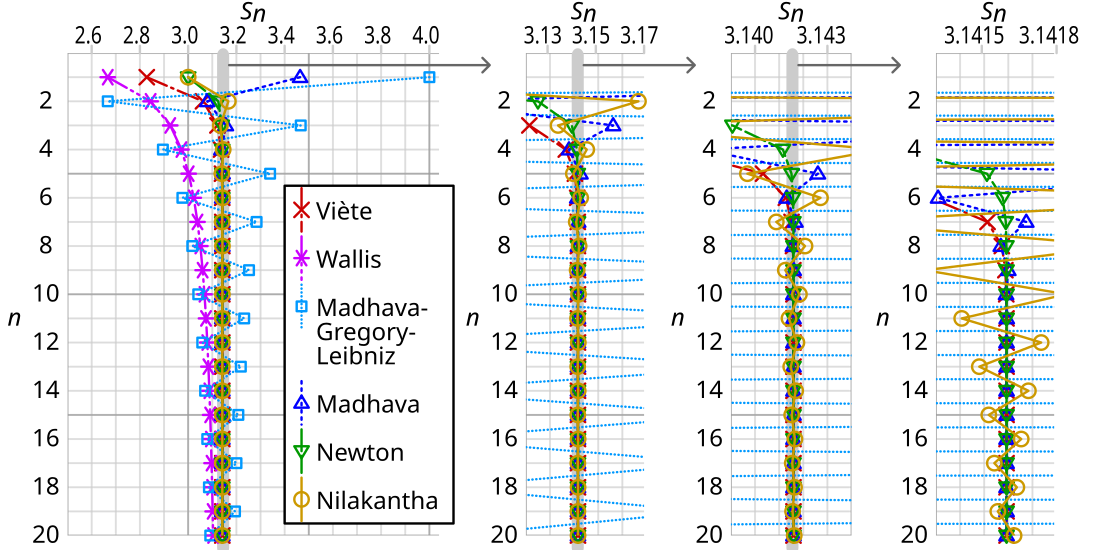Wallis derived this infinite product using interpolation, though his method is not regarded as rigorous. A modern derivation can be found by examining  for even and odd values of
for even and odd values of  , and noting that for large
, and noting that for large  , increasing
, increasing  by 1 results in a change that becomes ever smaller as
by 1 results in a change that becomes ever smaller as  increases. Let[2]
increases. Let[2]

(This is a form of Wallis' integrals.) Integrate by parts:

![{\displaystyle {\begin{aligned}\Rightarrow I(n)&=\int _{0}^{\pi }\sin ^{n}x\,dx\\[6pt]{}&=-\sin ^{n-1}x\cos x{\Biggl |}_{0}^{\pi }-\int _{0}^{\pi }(-\cos x)(n-1)\sin ^{n-2}x\cos x\,dx\\[6pt]{}&=0+(n-1)\int _{0}^{\pi }\cos ^{2}x\sin ^{n-2}x\,dx,\qquad n>1\\[6pt]{}&=(n-1)\int _{0}^{\pi }(1-\sin ^{2}x)\sin ^{n-2}x\,dx\\[6pt]{}&=(n-1)\int _{0}^{\pi }\sin ^{n-2}x\,dx-(n-1)\int _{0}^{\pi }\sin ^{n}x\,dx\\[6pt]{}&=(n-1)I(n-2)-(n-1)I(n)\\[6pt]{}&={\frac {n-1}{n}}I(n-2)\\[6pt]\Rightarrow {\frac {I(n)}{I(n-2)}}&={\frac {n-1}{n}}\\[6pt]\end{aligned}}}](//wikimedia.org/api/rest_v1/media/math/render/svg/fb327a4dcf3b4321e18cd38e4ab967de34205e3d)
Now, we make two variable substitutions for convenience to obtain:


We obtain values for  and
and  for later use.
for later use.
![{\displaystyle {\begin{aligned}I(0)&=\int _{0}^{\pi }dx=x{\Biggl |}_{0}^{\pi }=\pi \\[6pt]I(1)&=\int _{0}^{\pi }\sin x\,dx=-\cos x{\Biggl |}_{0}^{\pi }=(-\cos \pi )-(-\cos 0)=-(-1)-(-1)=2\\[6pt]\end{aligned}}}](//wikimedia.org/api/rest_v1/media/math/render/svg/61d7bb90cabaa8b31f60711a286f7d3905dc4470)
Now, we calculate for even values  by repeatedly applying the recurrence relation result from the integration by parts. Eventually, we end get down to
by repeatedly applying the recurrence relation result from the integration by parts. Eventually, we end get down to  , which we have calculated.
, which we have calculated.


Repeating the process for odd values  ,
,


We make the following observation, based on the fact that 


Dividing by  :
:
 , where the equality comes from our recurrence relation.
, where the equality comes from our recurrence relation.
By the squeeze theorem,





![{\displaystyle {\begin{aligned}{\frac {\pi }{2}}&=\prod _{n=1}^{\infty }{\frac {4n^{2}}{4n^{2}-1}}=\prod _{n=1}^{\infty }\left({\frac {2n}{2n-1}}\cdot {\frac {2n}{2n+1}}\right)\\[6pt]&={\Big (}{\frac {2}{1}}\cdot {\frac {2}{3}}{\Big )}\cdot {\Big (}{\frac {4}{3}}\cdot {\frac {4}{5}}{\Big )}\cdot {\Big (}{\frac {6}{5}}\cdot {\frac {6}{7}}{\Big )}\cdot {\Big (}{\frac {8}{7}}\cdot {\frac {8}{9}}{\Big )}\cdot \;\cdots \\\end{aligned}}}](http://wikimedia.org/api/rest_v1/media/math/render/svg/df59bf8aa67b6dff8be6cffb4f59777cea828454)




![{\displaystyle {\begin{aligned}\Rightarrow I(n)&=\int _{0}^{\pi }\sin ^{n}x\,dx\\[6pt]{}&=-\sin ^{n-1}x\cos x{\Biggl |}_{0}^{\pi }-\int _{0}^{\pi }(-\cos x)(n-1)\sin ^{n-2}x\cos x\,dx\\[6pt]{}&=0+(n-1)\int _{0}^{\pi }\cos ^{2}x\sin ^{n-2}x\,dx,\qquad n>1\\[6pt]{}&=(n-1)\int _{0}^{\pi }(1-\sin ^{2}x)\sin ^{n-2}x\,dx\\[6pt]{}&=(n-1)\int _{0}^{\pi }\sin ^{n-2}x\,dx-(n-1)\int _{0}^{\pi }\sin ^{n}x\,dx\\[6pt]{}&=(n-1)I(n-2)-(n-1)I(n)\\[6pt]{}&={\frac {n-1}{n}}I(n-2)\\[6pt]\Rightarrow {\frac {I(n)}{I(n-2)}}&={\frac {n-1}{n}}\\[6pt]\end{aligned}}}](http://wikimedia.org/api/rest_v1/media/math/render/svg/fb327a4dcf3b4321e18cd38e4ab967de34205e3d)




![{\displaystyle {\begin{aligned}I(0)&=\int _{0}^{\pi }dx=x{\Biggl |}_{0}^{\pi }=\pi \\[6pt]I(1)&=\int _{0}^{\pi }\sin x\,dx=-\cos x{\Biggl |}_{0}^{\pi }=(-\cos \pi )-(-\cos 0)=-(-1)-(-1)=2\\[6pt]\end{aligned}}}](http://wikimedia.org/api/rest_v1/media/math/render/svg/61d7bb90cabaa8b31f60711a286f7d3905dc4470)















![{\displaystyle {\begin{aligned}\Rightarrow {\frac {2}{\pi }}&=\prod _{n=1}^{\infty }\left(1-{\frac {1}{4n^{2}}}\right)\\[6pt]\Rightarrow {\frac {\pi }{2}}&=\prod _{n=1}^{\infty }\left({\frac {4n^{2}}{4n^{2}-1}}\right)\\[6pt]&=\prod _{n=1}^{\infty }\left({\frac {2n}{2n-1}}\cdot {\frac {2n}{2n+1}}\right)={\frac {2}{1}}\cdot {\frac {2}{3}}\cdot {\frac {4}{3}}\cdot {\frac {4}{5}}\cdot {\frac {6}{5}}\cdot {\frac {6}{7}}\cdots \end{aligned}}}](http://wikimedia.org/api/rest_v1/media/math/render/svg/74ce7488d92c2708916455e66c7770dbfed21150)

![{\displaystyle n!={\sqrt {2\pi n}}{\left({\frac {n}{e}}\right)}^{n}\left[1+O\left({\frac {1}{n}}\right)\right].}](http://wikimedia.org/api/rest_v1/media/math/render/svg/96fbe5666b3943b49f7279545f2d83f745c8bed2)



![{\displaystyle {\begin{aligned}p_{k}&={1 \over {2k+1}}\prod _{n=1}^{k}{\frac {(2n)^{4}}{[(2n)(2n-1)]^{2}}}\\[6pt]&={1 \over {2k+1}}\cdot {{2^{4k}\,(k!)^{4}} \over {[(2k)!]^{2}}}.\end{aligned}}}](http://wikimedia.org/api/rest_v1/media/math/render/svg/a4425b5472edd553ad732621d722aa0a7ddf13ab)




![{\displaystyle {\begin{aligned}\zeta (s)&=\sum _{n=1}^{\infty }{\frac {1}{n^{s}}},\Re (s)>1\\[6pt]\eta (s)&=(1-2^{1-s})\zeta (s)\\[6pt]&=\sum _{n=1}^{\infty }{\frac {(-1)^{n-1}}{n^{s}}},\Re (s)>0\end{aligned}}}](http://wikimedia.org/api/rest_v1/media/math/render/svg/fdf32ebbc781cbf33667c496c10e1231e0a10c3e)
![{\displaystyle {\begin{aligned}\eta (s)&={\frac {1}{2}}+{\frac {1}{2}}\sum _{n=1}^{\infty }(-1)^{n-1}\left[{\frac {1}{n^{s}}}-{\frac {1}{(n+1)^{s}}}\right],\Re (s)>-1\\[6pt]\Rightarrow \eta '(s)&=(1-2^{1-s})\zeta '(s)+2^{1-s}(\ln 2)\zeta (s)\\[6pt]&=-{\frac {1}{2}}\sum _{n=1}^{\infty }(-1)^{n-1}\left[{\frac {\ln n}{n^{s}}}-{\frac {\ln(n+1)}{(n+1)^{s}}}\right],\Re (s)>-1\end{aligned}}}](http://wikimedia.org/api/rest_v1/media/math/render/svg/e62998eb05e0fccc87195869efc243c134bad554)
![{\displaystyle {\begin{aligned}\Rightarrow \eta '(0)&=-\zeta '(0)-\ln 2=-{\frac {1}{2}}\sum _{n=1}^{\infty }(-1)^{n-1}\left[\ln n-\ln(n+1)\right]\\[6pt]&=-{\frac {1}{2}}\sum _{n=1}^{\infty }(-1)^{n-1}\ln {\frac {n}{n+1}}\\[6pt]&=-{\frac {1}{2}}\left(\ln {\frac {1}{2}}-\ln {\frac {2}{3}}+\ln {\frac {3}{4}}-\ln {\frac {4}{5}}+\ln {\frac {5}{6}}-\cdots \right)\\[6pt]&={\frac {1}{2}}\left(\ln {\frac {2}{1}}+\ln {\frac {2}{3}}+\ln {\frac {4}{3}}+\ln {\frac {4}{5}}+\ln {\frac {6}{5}}+\cdots \right)\\[6pt]&={\frac {1}{2}}\ln \left({\frac {2}{1}}\cdot {\frac {2}{3}}\cdot {\frac {4}{3}}\cdot {\frac {4}{5}}\cdot \cdots \right)={\frac {1}{2}}\ln {\frac {\pi }{2}}\\\Rightarrow \zeta '(0)&=-{\frac {1}{2}}\ln \left(2\pi \right)\end{aligned}}}](http://wikimedia.org/api/rest_v1/media/math/render/svg/3803d63abff3794e62b95627aefe28f36754d24f)
